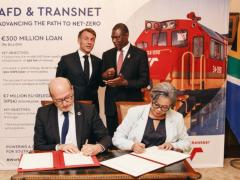Sasol’s feasibility study to explore the potential of Boegoebaai as an export hub for green hydrogen and ammonia should be completed within the next 24 months.
The Boegoebaai “green hydrogen” development has been designated a Strategic Integrated Project (SIP) in the South African National Development Plan and is located in the Namakwa Special Economic Zone (SEZ).
Sasol has been engaging with the Infrastructure and Investment Office (IIO) of the presidency to develop a hydrogen economy.
Minister in the Presidency, Mondli Gungubele, met with Sasol and other local stakeholders at the development site this week.
The company has signed a Memorandum of Agreement (MOA) with the Northern Cape Development Agency (NCEDA) to lead the feasibility study to explore the potential of Boegoebaai as an export hub for green hydrogen and ammonia.
Sasol said the outcomes of the feasibility study would determine the next steps of the development.
The project has the potential to produce up to 400 kilotons of hydrogen per annum, which will require renewable energy in the order of 9 gigawatts.
To put this into perspective, this equates to approximately 20% of South Africa’s installed energy capacity.
Sasol has also signed an MOA with the Gauteng Provincial Government to leverage SEZs that have been earmarked as enablers to unlock South Africa’s green hydrogen market.
This could potentially lead to the gas being used in the domestic transport and aviation sectors.
Sasol has partnered with the Industrial Development Corporation (IDC), which will provide joint funding for the feasibility study.
The Boegoebaai project is one of several green hydrogen, ammonia and power-to-X (P2X) opportunities, which Sasol is assessing as part of its new strategy, which is aligned with South Africa’s ambitions to establish the country as a significant green hydrogen production and global export hub.
Sasol has committed to be net-zero by 2050 and views green hydrogen as core to achieving its goal.













